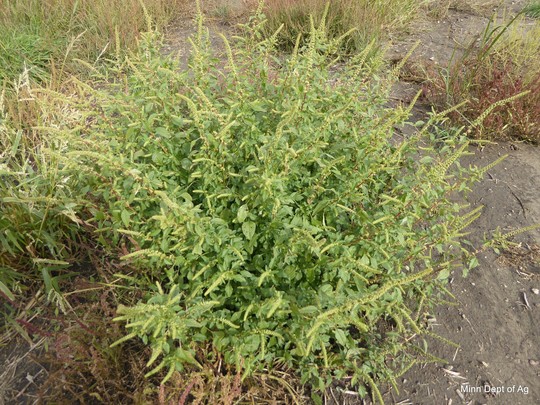|
August 4, 2020
August Weed of the Month: An Update on Palmer Amaranth After Years of Treatment in Minnesota
Shane Blair, Minnesota Department of Agriculture
Palmer amaranth (Amaranthus palmeri) was first found in Minnesota in 2016. Since then, small infestations have been documented along with identified pathways.
Palmer amaranth was originally brought into the state via a contaminated conservation seed mix and was planted in 34 plantings across Lyon and Yellow Medicine counties. Those plantings were surveyed and plants were identified. Walking through each individual planting helped the Minnesota Department of Agriculture (MDA) understand the plantings and helped determine the best action needed. Late in 2016, some plantings were propane weed torched to prevent seed production.
 A Palmer amaranth plant in a conservation planting.
Click here to download the image.
In 2017, plantings that had Palmer amaranth growing were managed with prescribed fire, propane weed torching, and hand pulling. Some plantings, but not all, also received an herbicide treatment to help slow the spread of Palmer. Management activities and surveys were completed multiple times throughout the growing season to ensure that Palmer amaranth did not establish itself. Plantings that had Palmer amaranth in 2016 and 2017 had no reemergence of Palmer in 2018 and 2019.
Some of those plantings continue to be surveyed, and, so far, no Palmer amaranth has been found. Surveys will continue until all known plantings where Palmer amaranth was planted are deemed eradicated. As each season passes, these conservation plantings are becoming very vibrant with multiple types of forbes and grasses. This is creating a lot of competition where Palmer amaranth and other unwanted weeds cannot compete.
A Palmer amaranth plant in a soybean field.
Click here to download the image.
Through stringent management activities and surveys, Palmer amaranth has not been able to produce seed and establish itself. More importantly, Palmer amaranth has not spread into neighboring fields where corn, soybean, and other row crops resided. The longer that we can protect Minnesota from Palmer amaranth and other aggressive weeds, the better we can protect the health of our agricultural economy.
Each season brings new Palmer amaranth findings and new pathways. However, more and more farmers and land managers are becoming aware of the weed and are notifying the proper authorities to help them manage the infestation. The Minnesota Department of Agriculture, University of Minnesota Extension, county agricultural inspectors, the Conservation Corps of Minnesota and Iowa, and landowners/managers continue to work together to manage the spread and detection of this plant. As each season progresses, lessons learned from scouting and managing this aggressive weed helps us to establish and improve best practices for limiting the spread.
MEDIA: For more information on Weed of the Month, contact Allen Sommerfeld, MDA Communications, at allen.sommerfeld@state.mn.us or 651-201-6185
Having trouble viewing this email? View it as a Web page.
|